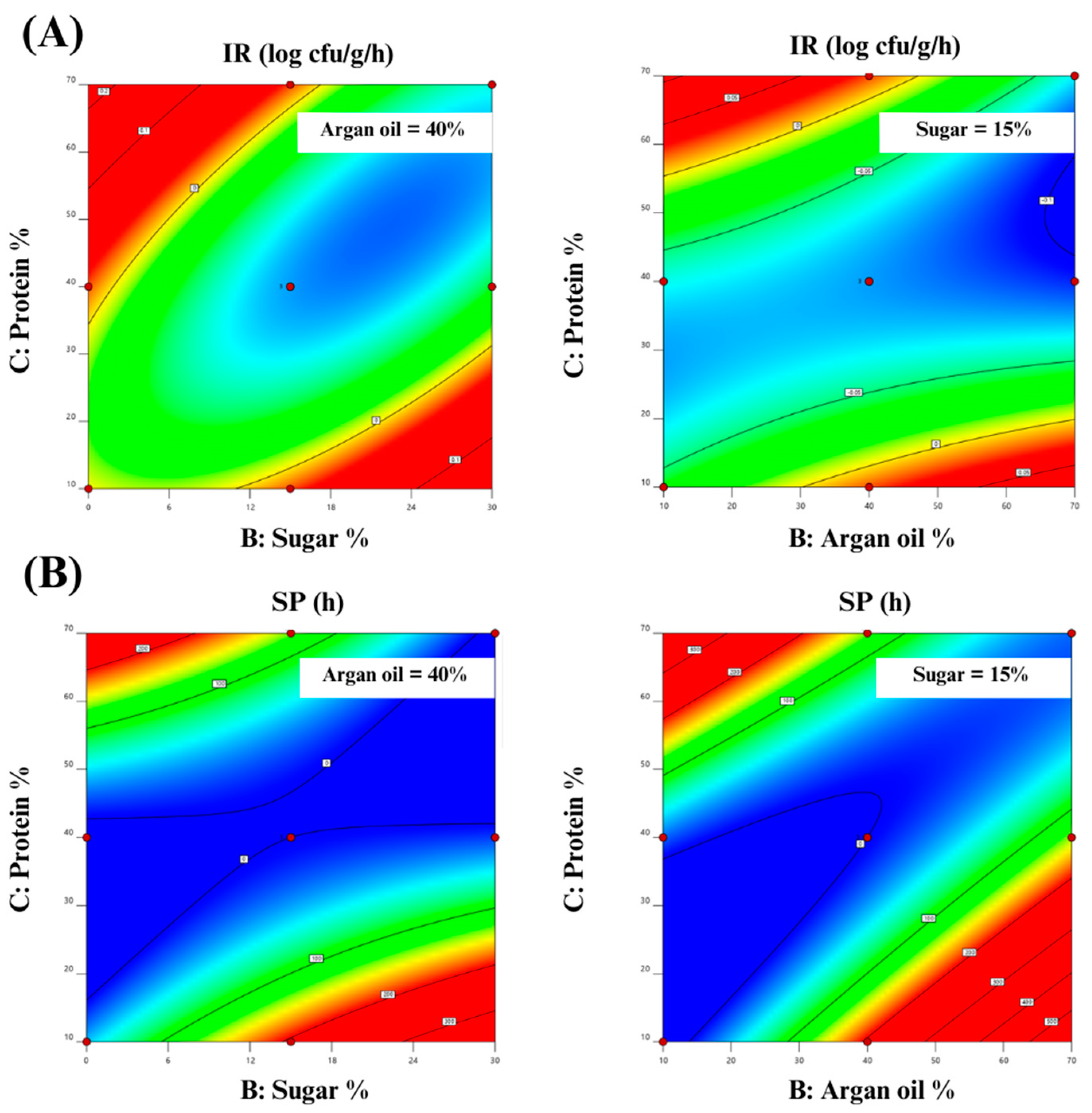Evaluating the Impact of Argan Oil, Sugar, and Peptone Concentrations on the Survival of Escherichia coli †
Abstract
:1. Introduction
2. Materials and Methods
2.1. Bacterial Strain and Preparation
2.2. Preparation of Amlou-like Medium
2.3. Experimental Design
2.4. Microbial Enumeration
2.5. Statistical Analysis and Modeling
2.6. Model Performance Assessment
3. Results and Discussion
4. Conclusions
Author Contributions
Funding
Institutional Review Board Statement
Informed Consent Statement
Data Availability Statement
Conflicts of Interest
References
- Charrouf, Z.; Guillaume, D. Should the amazigh diet (regular and moderate argan-oil consumption) have a beneficial impact on human health? Crit. Rev. Food Sci. Nutr. 2010, 50, 473–477. [Google Scholar] [CrossRef] [PubMed]
- Capozzi, V.; Fragasso, M.; Russo, P. Microbiological Safety and the Management of Microbial Resources in Artisanal Foods and Beverages: The Need for a Transdisciplinary Assessment to Conciliate Actual Trends and Risks Avoidance. Microorganisms 2020, 8, 306. [Google Scholar] [CrossRef] [PubMed]
- Ezzaky, E.; Zanzan, M.; Achemchem, F.; Valero, A.; Hamadi, F. Microbiological profile and modeling the survival of Escherichia coli ATCC 25922 in Amlou: A traditional Moroccan spread food. Microb. Risk Anal. 2022, 21, 100216. [Google Scholar] [CrossRef]
- Baranyi, J.; Roberts, T.A. Mathematics of predictive food microbiology. Int. J. Food Microbiol. 1995, 26, 199–218. [Google Scholar] [CrossRef] [PubMed]
- Dong, Q.; Tu, K.; Guo, L.; Li, H.; Zhao, Y. Response surface model for prediction of growth parameters from spores of Clostridium sporogenes under different experimental conditions. Food Microbiol. 2007, 24, 624–632. [Google Scholar] [CrossRef] [PubMed]
- Davami, F.; Eghbalpour, F.; Nematollahi, L.; Barkhordari, F.; Mahboudi, F. Effects of Peptone Supplementation in Different Culture Media on Growth, Metabolic Pathway and Productivity of CHO DG44 Cells a New Insight into Amino Acid Profiles. Iran. Biomed. J. 2015, 19, 194–205. [Google Scholar] [PubMed]
- McQuestin, O.J.; Shadbolt, C.T.; Ross, T. Quantification of the relative effects of temperature, pH, and water activity on inactivation of Escherichia coli in fermented meat by meta-analysis. Appl. Environ. Microbiol. 2009, 75, 6963–6972. [Google Scholar] [CrossRef] [PubMed]
- Amezaga, M.R.; Booth, I.R. Osmoprotection of Escherichia coli by peptone is mediated by the uptake and accumulation of free proline but not of proline-containing peptides. Appl. Environ. Microbiol. 1999, 65, 5272–5278. [Google Scholar] [CrossRef] [PubMed]

| Factors | Output | |||
|---|---|---|---|---|
| Peptone % | Sugar % | Argan Oil % | IR (log CFU/g/h) | SP (h) |
| 40 | 15 | 40 | −0.0814 | 0 |
| 40 | 15 | 40 | −0.0766 | 0 |
| 40 | 15 | 40 | −0.0738 | 0 |
| 70 | 15 | 40 | 0.0292 | 140.20 |
| 10 | 15 | 40 | 0.0107 | 199.72 |
| 40 | 30 | 40 | −0.0253 | 0 |
| 40 | 0 | 40 | 0.00487 | 0 |
| 40 | 15 | 70 | −0.0977 | 156.69 |
| 40 | 15 | 10 | −0.0607 | 0 |
| 40 | 30 | 70 | −0.0602 | 0 |
| 70 | 15 | 70 | −0.0608 | 0 |
| 10 | 15 | 10 | −0.0451 | 0 |
| 70 | 30 | 40 | −0.0763 | 0 |
| 10 | 0 | 40 | 0.0113 | 25.41 |
| Response Variable | ||||
|---|---|---|---|---|
| Factors | IR (log cfu/g/h) | SP (h) | ||
| F | p | F | p | |
| Model | 15.48 | 0.002 | 16.35 | 0.004 |
| A-Argan oil | 4.29 | 0.084 | 22.39 | 0.005 |
| B-Sugar | 19.40 | 0.005 | 1.04 | 0.356 |
| C-Peptone | 0.02 | 0.894 | 11.79 | 0.019 |
| AB | - | - | 20.48 | 0.006 |
| AC | 27.34 | 0.002 | 75.46 | 0.000 |
| BC | 45.58 | 0.001 | 51.45 | 0.001 |
| A2 | 18.25 | 0.008 | ||
| B2 | 38.29 | 0.001 | - | - |
| C2 | 70.56 | 0.000 | 85.86 | 0.000 |
| Adjusted R2 | 0.89 | 0.90 | ||
Disclaimer/Publisher’s Note: The statements, opinions and data contained in all publications are solely those of the individual author(s) and contributor(s) and not of MDPI and/or the editor(s). MDPI and/or the editor(s) disclaim responsibility for any injury to people or property resulting from any ideas, methods, instructions or products referred to in the content. |
© 2023 by the authors. Licensee MDPI, Basel, Switzerland. This article is an open access article distributed under the terms and conditions of the Creative Commons Attribution (CC BY) license (https://creativecommons.org/licenses/by/4.0/).
Share and Cite
Ezzaky, Y.; Zanzan, M.; Elidrissi, A.; Boussif, K.; Achemchem, F. Evaluating the Impact of Argan Oil, Sugar, and Peptone Concentrations on the Survival of Escherichia coli. Biol. Life Sci. Forum 2023, 26, 2. https://doi.org/10.3390/Foods2023-15005
Ezzaky Y, Zanzan M, Elidrissi A, Boussif K, Achemchem F. Evaluating the Impact of Argan Oil, Sugar, and Peptone Concentrations on the Survival of Escherichia coli. Biology and Life Sciences Forum. 2023; 26(1):2. https://doi.org/10.3390/Foods2023-15005
Chicago/Turabian StyleEzzaky, Youssef, Mariem Zanzan, Ahmed Elidrissi, Kaoutar Boussif, and Fouad Achemchem. 2023. "Evaluating the Impact of Argan Oil, Sugar, and Peptone Concentrations on the Survival of Escherichia coli" Biology and Life Sciences Forum 26, no. 1: 2. https://doi.org/10.3390/Foods2023-15005
APA StyleEzzaky, Y., Zanzan, M., Elidrissi, A., Boussif, K., & Achemchem, F. (2023). Evaluating the Impact of Argan Oil, Sugar, and Peptone Concentrations on the Survival of Escherichia coli. Biology and Life Sciences Forum, 26(1), 2. https://doi.org/10.3390/Foods2023-15005







